1998 OLDSMOBILE SILHOUETTE phone
[x] Cancel search: phonePage 183 of 444
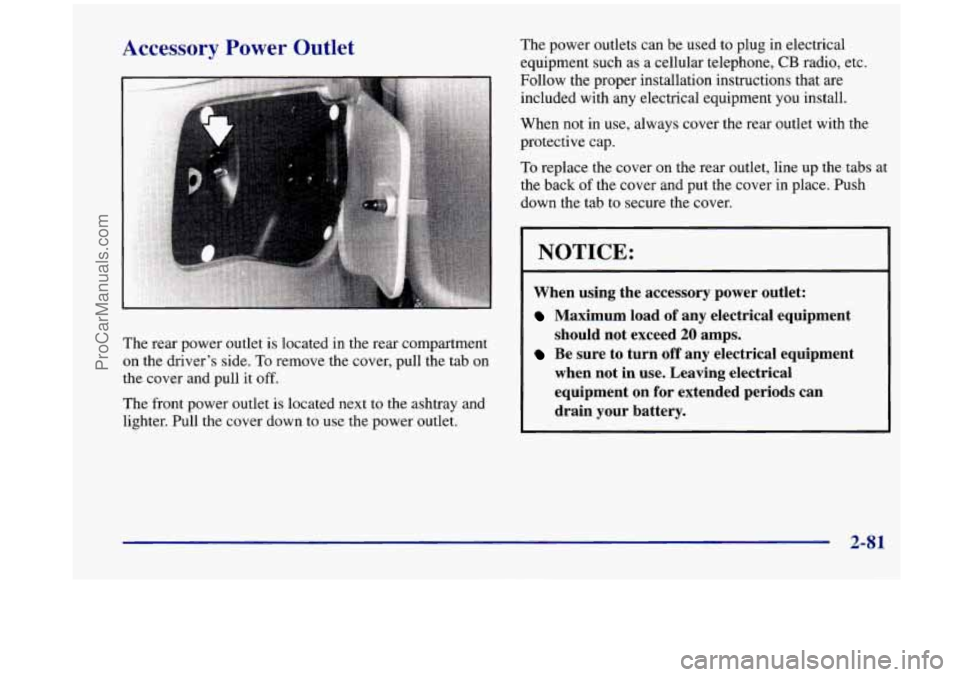
Accessory Power Outlet
The rear power outlet is located in the rear compartment
on the driver’s side. To remove the cover, pull the tab on
the cover and pull it
off.
The front power outlet is located next to the ashtray and
lighter. Pull the cover down to use the power outlet. The
power outlets can be used to plug in electrical
equipment such as a cellular telephone,
CB radio, etc.
Follow the proper installation instructions that are
included with any electrical equipment you install.
When not in use, always cover the rear outlet with the
protective cap.
To replace the cover on the rear outlet, line up the tabs at
the back
of the cover and put the cover in place. Push
down the tab to secure the cover.
NOTICE:
When using the accessory power outlet:
Maximum load of any electrical equipment
should not exceed
20 amps.
Be sure to turn off any electrical equipment
when not in use. Leaving electrical
equipment on for extended periods can
I drain your battery.
2-81
-
ProCarManuals.com
Page 222 of 444
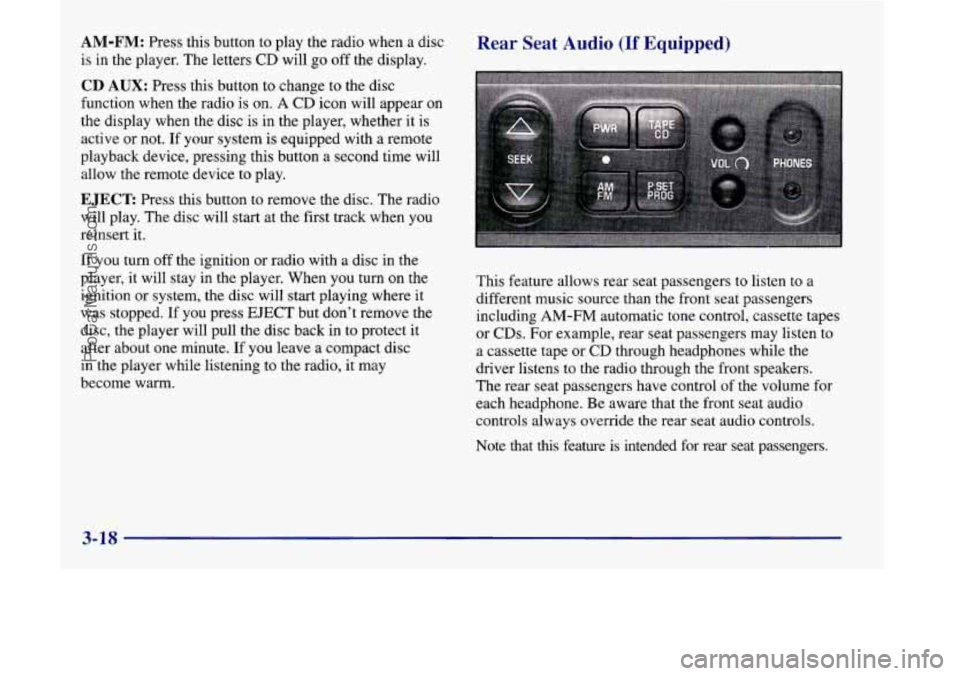
If you turn off the ignition or radio with a disc in the
player, it will stay in the player. When you turn on the
ignition or system, the disc will start playing where it
was stopped.
If you press EJECT but don’t remove the
disc, the player will pull the disc back in to protect it
after about one minute. If you leave a compact disc
in the player while listening to the radio, it may
become warm. This feature
allows rear seat passengers to listen to a
different music source than the front seat passengers
including AM-FM automatic tone control, cassette tapes
or
CDs. For example, rear seat passengers may listen to
a cassette tape or CD through headphones while the
driver listens to the radio through the front speakers.
The rear seat passengers have control of the volume for
each headphone. Be aware that the front seat audio
controls always override the rear seat audio controls.
Note that
this feature is intended for rear seat passengers.
3-18
ProCarManuals.com
Page 223 of 444

PWR: Press this button to turn the rear seat audio system
on or off. The rear speakers will be muted when the power
is turned on. You may operate the rear seat audio functions
even when the primary radio power is
off.
VOL: Press this knob lightly so it extends. Turn the
knob to the right to increase volume and to the left to
decrease volume. Push the knob back into its stored
position when you’re not using
it. The upper VOL knob
controls the upper headphone and the lower
VOL knob
controls the lower headphone.
AM-FM: Press this button to switch between AM, FMl
and FM2. If the front passengers are already listening
to
AM-FM, the rear seat audio controller will not switch
between the bands and cannot change the frequency.
SEEK: Press the up arrow to tune to the next higher
station and stay there. Press the down arrow to tune to
the next lower station and stay there. The sound will
mute while seeking. The SEEK button is inactive
if the
AM-FM mode on the front radio is in use.
If your vehicle is equipped with the AM-FM Stereo with
Cassette Tape Player and Automatic Tone Control, while
listening to a cassette tape, press the up arrow to hear the
next selection on the tape. Press the down arrow to
go
back to the previous selection. The SEEK button is
inactive if the cassette mode on the front radio is in use.
If your vehicle is equipped with the AM-FM Stereo with
Compact Disc Player and Automatic Tone Control or the
Remote Compact Disc Player, while listening
to a
compact disc, press the up arrow
to hear the next
selection
on the compact disc. Press the down arrow to
go back to the previous selection. The SEEK button is
inactive if the CD mode on the front radio is in use.
P.SET PROG: The front passengers must be listening
to something different for each
of these functions
to work:
Press this button to seek through your preset radio
stations set on your primary radio pushbuttons.
When a cassette tape is playing, press this button to
go to the other side of the tape.
TAPE CD: With a cassette tape in the player and the
radio playing, press this button to play a cassette tape.
Press TAPE CD to switch between the tape and compact
disc
if both are loaded. Press AM-FM to return to the
radio when a cassette tape or compact disc is playing.
The inactive tape or CD will remain safely inside the
radio for future listening.
ProCarManuals.com
Page 229 of 444
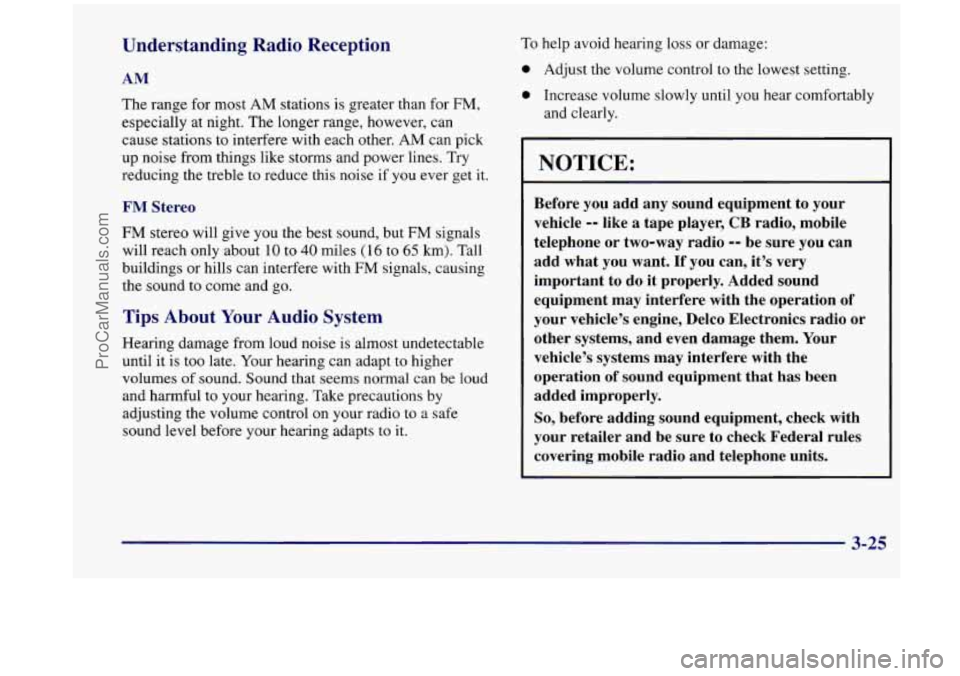
Understanding Radio Reception
AM
The range for most AM stations is greater than for FM,
especially at night. The longer range, however, can
cause stations to interfere with each other. AM can pick
up noise from things like storms and power lines. Try
reducing the treble to reduce this noise if you ever get
it.
FM Stereo
FM stereo will give you the best sound, but FM signals
will reach only about
10 to 40 miles ( 16 to 65 km). Tall
buildings or hills can interfere with
FM signals, causing
the sound to come and go.
Tips About Your Audio System
Hearing damage from loud noise is almost undetectable
until it is too late. Your hearing can adapt to higher
volumes
of sound. Sound that seems normal can be loud
and harmful to your hearing. Take precautions by
adjusting the volume control on your radio to a safe
sound level before your hearing adapts
to it.
To help avoid hearing loss or damage:
0 Adjust the volume control to the lowest setting.
0 Increase volume slowly until you hear comfortably
and clearly.
NOTICE:
~ Before you add any sound equipment to your
vehicle
-- like a tape player, CB radio, mobile
telephone or two-way radio
-- be sure you can
add what you want.
If you can, it’s very
important to do it properly. Added sound
equipment may interfere with the operation
of
your vehicle’s engine, Delco Electronics radio or
other systems, and even damage them. Your
vehicle’s systems may interfere with the
operation of sound equipment that
has been
added improperly.
So, before adding sound equipment, check with
your retailer and be sure to check Federal rules
covering mobile radio and telephone units.
3-25
ProCarManuals.com
Page 234 of 444
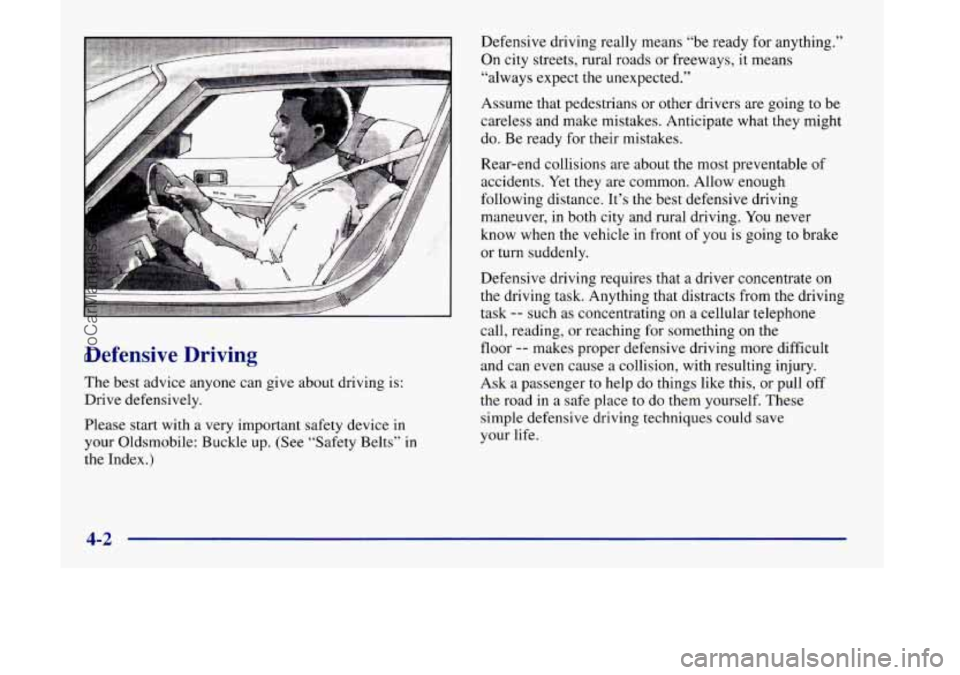
Defensive Driving
The best advice anyone can give about driving is:
Drive defensively.
Please start with a very important safety device in
your Oldsmobile: Buckle up. (See “Safety Belts” in
the Index.) Defensive driving really means “be ready
for anything.”
On city streets, rural roads or freeways, it means
“always expect the unexpected.”
Assume that pedestrians or other drivers are going to be
careless and make mistakes. Anticipate what they might
do. Be ready for their mistakes.
Rear-end collisions are about the most preventable of
accidents. Yet
they are common. Allow enough
following distance.
It’s the best defensive driving
maneuver, in both city and rural driving. You never
know when the vehicle in front of you is going to brake
or
turn suddenly.
Defensive driving requires that a driver concentrate on
the driving task. Anything that distracts from the driving
task
-- such as concentrating on a cellular telephone
call, reading, or reaching for something on the
floor
-- makes proper defensive driving more difficult
and can even cause a collision, with resulting injury.
Ask a passenger to help do things like this, or pull
off
the road in a safe place to do them yourself. These
simple defensive driving techniques could save
your life.
4-2
ProCarManuals.com
Page 252 of 444
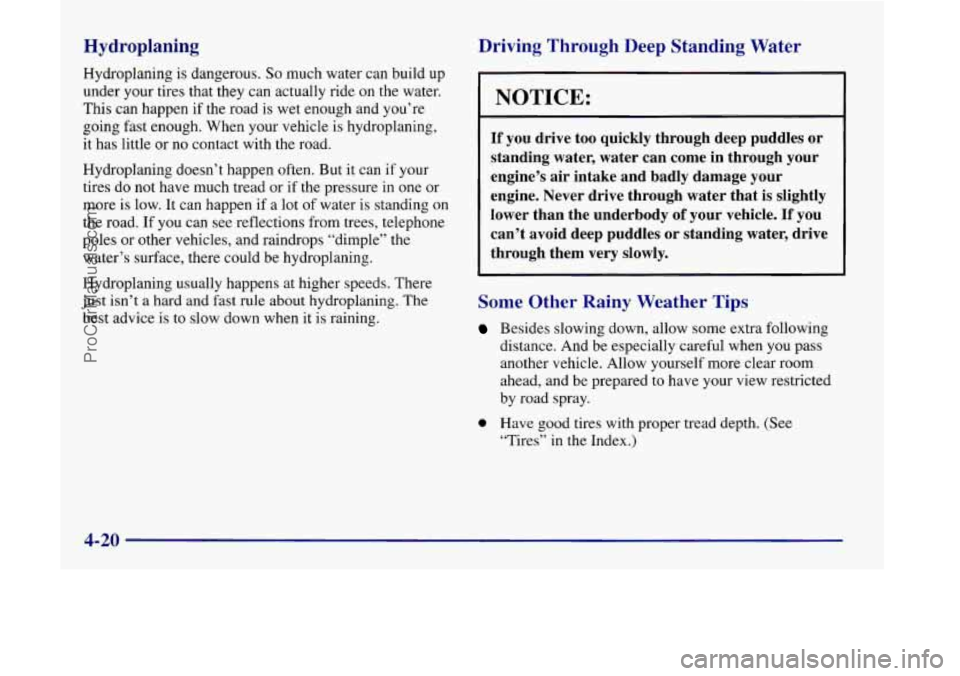
Hydroplaning
Hydroplaning is dangerous. So much water can build up
under your tires that they can actually ride on the water.
This can happen if the road is wet enough and you’re
going fast enough. When your vehicle is hydroplaning,
it has little or
no contact with the road.
Hydroplaning doesn’t happen often. But it can if your
tires do not have much tread or if the pressure in one or
more
is low. It can happen if a lot of water is standing on
the road. If you can see reflections from trees, telephone
poles
or other vehicles, and raindrops “dimple” the
water’s surface, there could be hydroplaning.
Hydroplaning usually happens at higher speeds. There
just isn’t a hard and fast rule about hydroplaning. The
best advice is
to slow down when it is raining.
Driving Through Deep Standing Water
- .-
NOTICE:
If you drive too quickly through deep puddles or
standing water, water can come in through your
engine’s air intake and badly damage your
engine. Never drive through water that is slightly
lower than the underbody
of your vehicle. If you
can’t avoid deep puddles or standing water, drive
through them very slowly.
Some Other Rainy Weather Tips
Besides slowing down, allow some extra following
distance. And be especially careful when you pass
another vehicle. Allow yourself more clear room
ahead, and be prepared to have your view restricted
by road spray.
0 Have good tires with proper tread depth. (See
“Tires” in the Index.)
4-20
ProCarManuals.com
Page 415 of 444
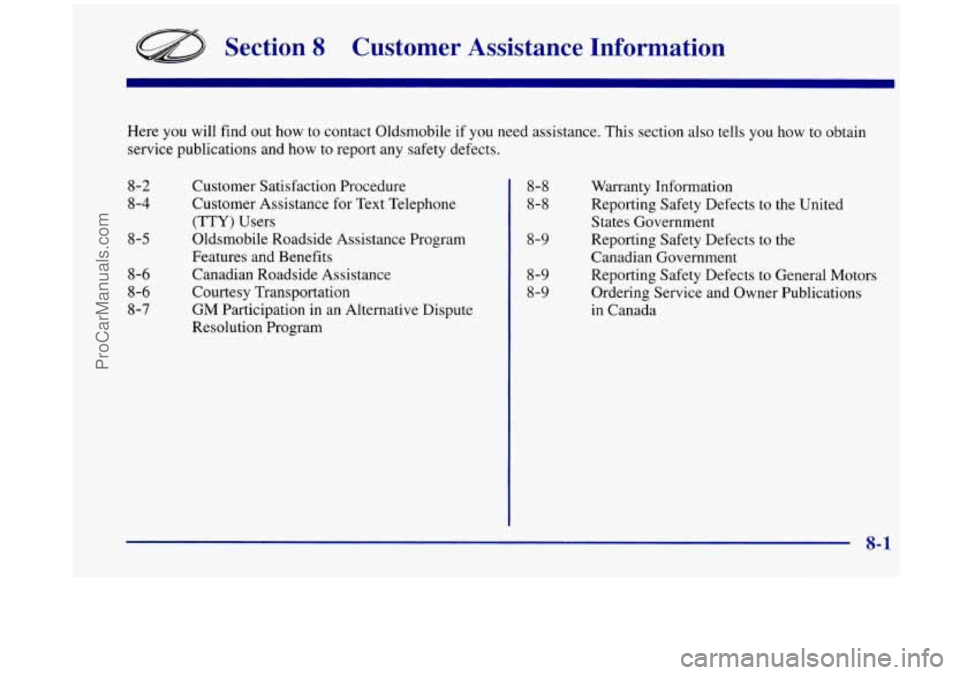
Section 8 Customer Assistance Information
Here you will find out how to contact Oldsmobile if you need assistance. This section also tells you how to obtain
service publications and how
to report any safety defects.
8-2
8-4
8-5
8-6
8-6
8-7
Customer Satisfaction Procedure
Customer Assistance for Text Telephone
(TTY) Users
Oldsmobile Roadside Assistance Program
Features and Benefits
Canadian Roadside Assistance
Courtesy Transportation
GM Participation
in an Alternative Dispute
Resolution Program 8-8
8-8
8-9
8-9
8-9
Warranty
Information
Reporting Safety Defects to the United
States Government
Reporting Safety Defects to the
Canadian Government
Reporting Safety Defects to General Motors Ordering Service and Owner Publications
in Canada
ProCarManuals.com
Page 418 of 444
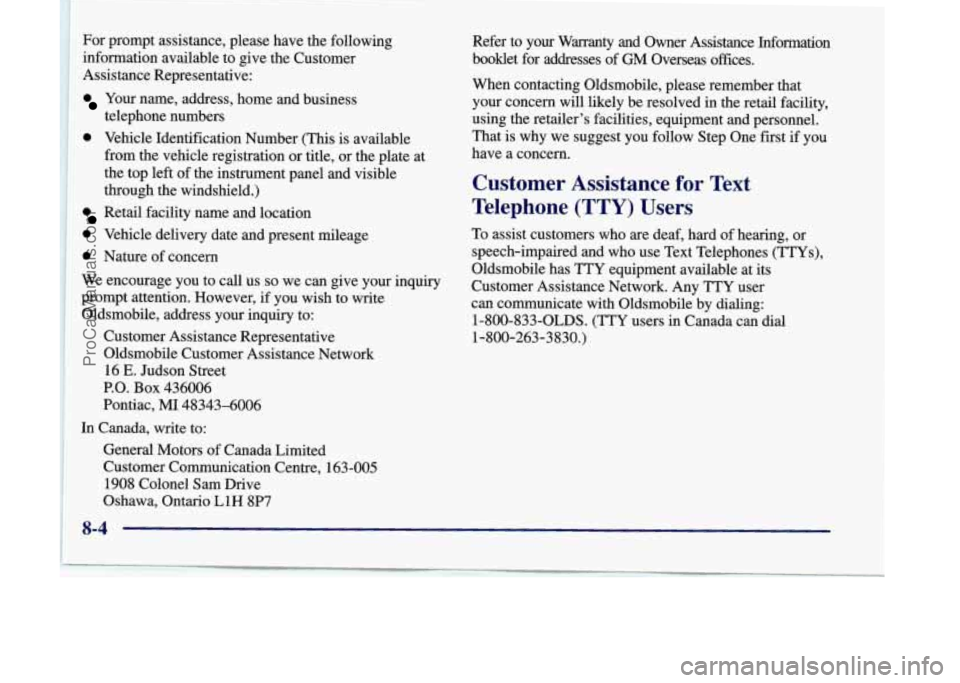
For prompt assistance, please have the following
information available
to give the Customer
Assistance Representative:
Your name, address, home and business
telephone numbers
0 Vehicle Identification Number (This is available
from the vehicle registration or title, or the plate at
the top left of the instrument panel and visible
through the windshield.)
Retail facility name and location
0 Vehicle delivery date and present mileage
0 Nature of concern
We encourage you to call us
so we can give your inquiry
prompt attention. However,
if you wish to write
Oldsmobile, address your inquiry to:
Customer Assistance Representative
Oldsmobile Customer Assistance Network 16
E. Judson Street
P.O. Box 436006
Pontiac, MI 48343-6006
In Canada, write to:
General Motors of Canada Limited
Customer Communication Centre, 163-005
1908 Colonel
Sam Drive
Oshawa, Ontario L1H 8P7 Refer to
your Warranty and Owner Assistance Information
booklet for addresses of GM Overseas offices.
When contacting Oldsmobile, please remember that
your concern
will likely be resolved in the retail facility,
using the retailer’s facilities, equipment and personnel.
That is why we suggest you follow Step One first if you
have a concern.
Customer Assistance for Text
Telephone (TTY)
Users
To assist customers who are deaf, hard of hearing, or
speech-impaired and who use Text Telephones
(TTYs),
Oldsmobile has TTY equipment available at its
Customer Assistance Network. Any TTY user
can communicate with Oldsmobile by dialing:
1-800-833-OLDS. (TTY users in Canada can
dial
1-800-263-3830.)
8-4
ProCarManuals.com